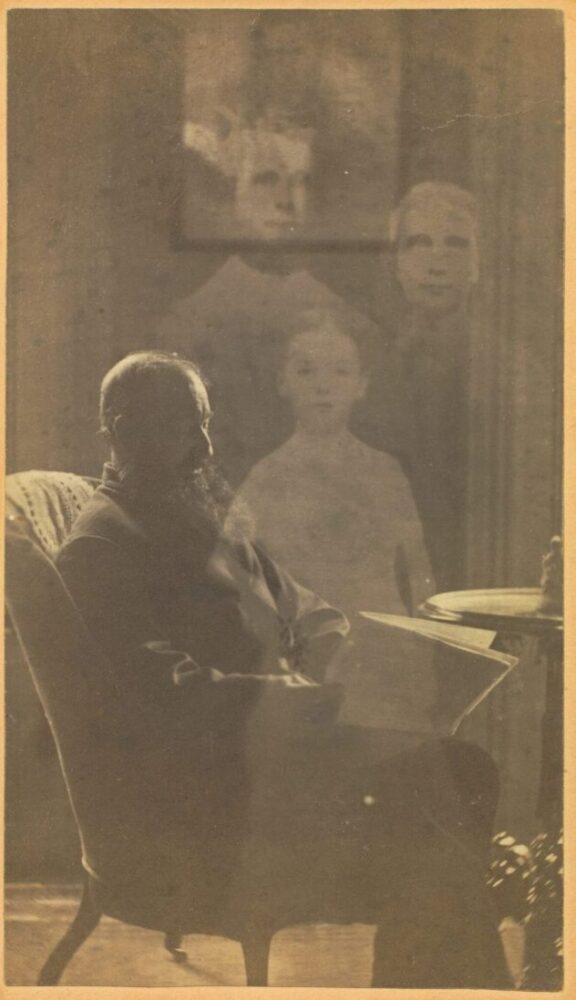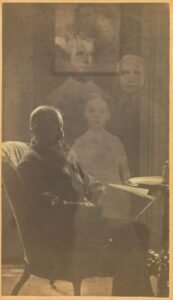Spiritualism
Spiritualism, a practice centered on communicating with the spirits of the dead, influenced several religious groups in Louisiana.

Getty
Unidentified man with a long beard seated with three “spirits.” Photo by William H. Mumler.
The religious movement known as Modern American Spiritualism centers on the practice of communicating with the spirits of the dead. It started in March of 1848 just outside Rochester, New York, when a pair of young sisters began communicating with the spirit of an allegedly murdered peddler. The girls, Maggie and Kate Fox, became an instant sensation in upstate New York, and with the guidance and management of their older sister Leah, they became nationally renowned. Soon afterward, the practice of communicating with the spirits of the dead—the séance—surged in popularity in the United States and across parts of Europe. The movement hit its peak in the latter nineteenth century, and historical contemporaries estimate that around six million Americans practiced Spiritualism, from San Francisco to Boston. It was most popular among white, liberal Protestants in the northeastern region of the United States, though Afro-Creole men calling themselves the Cercle Harmonique practiced the religion in post-Civil War New Orleans.
Spiritualism offered answers that other religions could not. It is natural for people to wonder what happens after death, and Spiritualism claims to offer tangible proof for believers by connecting with the spirits of the dead and learning about the world after this one. The popularity of Spiritualism ebbed and flowed, often in conjunction with widespread death, first with the Civil War and second with World War I and the following influenza pandemic. Key beliefs of the movement center on the possibility of communication with the dead and the “Golden Rule” to treat others well—providing considerable flexibility in the tradition.
Spiritualism was a diverse movement without formalized beliefs until the creation of the National Spiritualist Association of Churches in the 1890s. Some considered Spiritualism to be complimentary to Christianity, while others in the movement deemed traditional Christianity to be too patriarchal. Anyone might be a medium for spirit communication, and many of them were women during a time when religious leadership was solely the domain of men. The tradition continues today, primarily led by women, and emphasizes empowerment. After all, Spiritualism was closely aligned with the women’s rights movement for suffrage in the early twentieth century and with the earlier abolitionist movement the century before.
Spiritualism includes both those who can communicate with spirits, who are known as mediums, and those who believe and participate in séances but cannot directly connect with the dead themselves. Notable Spiritualists include Mary Todd Lincoln (who sought mediums to communicate with her dead son and murdered husband); Victoria Woodhull (the first woman to run for US president in 1872); Sir Arthur Conan Doyle (author of the Sherlock Holmes series); and Sojourner Truth (activist for Black rights and women’s rights).
Mediumship practices varied and have evolved over the years. The Fox sisters mediated rapping or knocking noises from the spirits with a predetermined number of knocks for answering yes-or-no questions. Table tipping involves answering questions while the medium and others place their hands on the table and moving it to connect with spirits. Spirit photography used then-new camera technology to capture images of the spirits of the dead—a practice made infamous by the charlatan William Mumler, who was put on trial for the practice. Spirit photography continues today, using smartphone cameras. Around the turn of the twentieth century, some mediums claimed to enable full-fledged materializations of the dead that others could touch and smell. The planchette, a small wooden plank with a pencil attached for automatic writing, became incredibly popular starting in the 1870s. Other Spiritualists used alphabet dials, which were wheels printed with letters, and waited for the spirits to spin the dial and spell out messages. The dials were the originators of alphabet boards, including the famous Ouija board. Perhaps the simplest communication method with spirits was—and remains—to simply allow them to speak through mediums themselves.
Spiritualism was not without controversy, and some mediums were exposed as frauds. Maggie Fox published a confession in the New York World in October 1888, in which she admitted that the “raps” people heard were her and her sister Kate cracking their joints. Even though she recanted that confession less than a year later, it damaged the movement’s reputation. One of the most fervent debunkers of Spiritualism was famed magician Harry Houdini. He argued that all mediums were greedy exploiters of those in mourning and disputed this before a US congressional committee in 1926. However, he and other magicians took some inspiration for their acts from Spiritualist mediums.
After the 1920s Spiritualism’s popularity began to wane, due in part to the bad publicity wrought by Houdini and from modern science’s ability to debunk the practice. Spiritualist churches and communities can still be easily found across the Unites States but in much smaller numbers than before. For example, Spiritualist summer camps, or seasonal communities that become summertime hubs of Spiritualism, can be found in Lily Dale, New York, and Camp Etna, Maine.
As mainstream Spiritualism began to wane in the 1920s, Black Spiritual churches developed across Louisiana after foundress Mother Leafy Anderson moved from Chicago to New Orleans. These churches blend Spiritualism with Voudou, Pentecostalism, and Catholicism. Like Spiritualism, most leadership positions in Black Spiritual churches have been held by women. Practices include speaking in tongues, communicating with spirits, healing, and prophecy. Population displacement after Hurricane Katrina and gentrification have led to a recent decline in the religion’s popularity.
